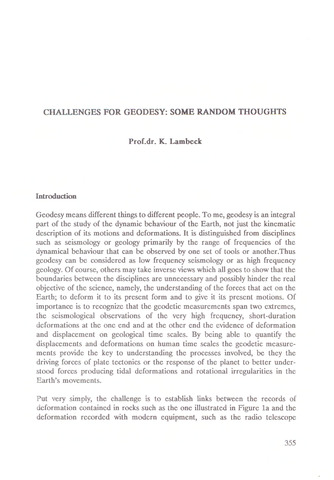CHALLENGES FOR GEODESY: SOME RANDOM THOUGHTS
Prof.dr. K. Lambeck
Introduction
Geodesy means different things to different people. To me, geodesy is an integral
part of the study of the dynamic behaviour of the Earth, not just the kinematic
description of its motions and deformations. It is distinguished from disciplines
such as seismology or geology primarily by the range of frequencies of the
dynamical behaviour that can be observed by one set of tools or another.Thus
geodesy can be considered as low frequency seismology or as high frequency
geology. Of course, others may take inverse views which all goes to show that the
boundaries between the disciplines are unnecessary and possibly hinder the real
objective of the science, namely, the understanding of the forces that act on the
Earth; to deform it to its present form and to give it its present motions. Of
importance is to recognize that the geodetic measurements span two extremes,
the seismological observations of the very high frequency, short-duration
deformations at the one end and at the other end the evidence of deformation
and displacement on geological time scales. By being able to quantify the
displacements and deformations on human time scales the geodetic measure
ments provide the key to understanding the processes involved, be they the
driving forces of plate tectonics or the response of the planet to better under
stood forces producing tidal deformations and rotational irregularities in the
Earth's movements.
Put very simply, the challenge is to establish links between the records of
deformation contained in rocks such as the one illustrated in Figure la and the
deformation recorded with modern equipment, such as the radio telescope
355

